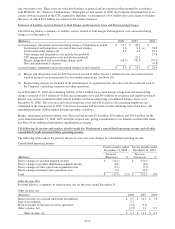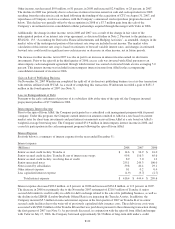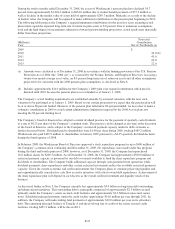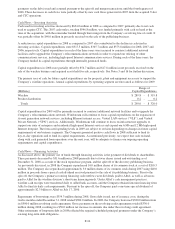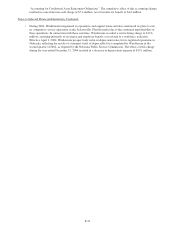Windstream 2008 Annual Report Download - page 117
Download and view the complete annual report
Please find page 117 of the 2008 Windstream annual report below. You can navigate through the pages in the report by either clicking on the pages listed below, or by using the keyword search tool below to find specific information within the annual report.
See Notes 2 and 8 for additional information on Windstream’s pension and other postretirement plans.
Useful Lives of Assets – The calculation of depreciation and amortization expense is based on the estimated economic
useful lives of the underlying property, plant and equipment and finite-lived intangible assets. As discussed in Note 2,
the Company reduced the depreciation rates on property, plant and equipment used in its operating markets based on
studies completed between 2006 and 2007 of the related lives of those assets. Although we believe it is unlikely that
any further significant changes to the useful lives of our finite-lived intangible assets will occur in the near term, rapid
changes in technology or changes in market conditions could result in revisions to such estimates that could materially
affect the carrying value of these assets and our future consolidated operating results. The Company realized reductions
in its depreciation expense in 2008, which is the first full year following the completion of certain rate studies.
Goodwill and Other Indefinite-lived Intangibles – In accordance with SFAS No. 142, “Goodwill and Other Intangible
Assets”, we test our goodwill for impairment at least annually, or whenever indicators of impairment arise. SFAS
No. 142 requires write-downs of goodwill only in periods in which the recorded amount of goodwill exceeds the fair
value. The fair value of goodwill is determined by estimating the fair value of the reporting units to which it has been
assigned. The fair value of a reporting unit is calculated utilizing a combination of the discounted cash flows of the
reporting unit and the calculated market values of comparable companies. If the fair value of the reporting unit is less
than its carrying value, a second calculation is required in which the implied fair value of goodwill is compared to its
carrying value. If the implied fair value of goodwill is less than its carrying value, goodwill must be written down to its
implied fair value.
SFAS No. 142 requires that we evaluate the remaining useful lives of our other indefinite-lived intangible assets and
test them for impairment at least annually, or more frequently if events or changes in circumstances indicate that the
asset may be impaired. If the carrying value of an indefinite-lived intangible asset exceeds its fair value, an impairment
loss is recognized in an amount equal to the excess. Windstream determines the fair value of its indefinite-lived
intangible assets using a combination of cost-based and income-based approaches.
The Company performs its impairment analysis on January 1st of each year. In addition, as a result of the sale of the
publishing business, Windstream performed an impairment analysis as of November 30, 2007 to assess the impact of
foregoing future royalty revenue payments from the directory publishing business on its indefinite-lived wireline
franchise rights. During 2008, 2007 and 2006, no write-downs in the carrying values of either goodwill or indefinite-
lived intangible assets were required based on their calculated fair values. Reducing the January 1, 2008 calculated fair
values of goodwill by 10 percent, and the wireline franchise rights in the Kentucky operating markets by 5 percent,
would not have resulted in an impairment of the carrying value of the related assets. Decreasing the January 1, 2008
calculated fair value of the wireline franchise rights in the former Valor operating markets by 5 percent, however,
would have resulted in an impairment charge of approximately $11.0 million in 2008 on the Company’s wireline
franchise rights. Changes in the key assumptions used in the discounted cash flow analysis due to changes in market
conditions could adversely affect the calculated fair values of goodwill and other indefinite-lived intangible assets,
materially affecting the carrying value of these assets and our future consolidated operating results.
Derivative Instruments – SFAS No. 133, “Accounting for Derivative Instruments and Hedging Activities”, as
amended, provides guidance on accounting for derivatives, including interest rate swaps. In addition, SFAS No. 133
governs when a derivative or other financial instrument can be designated as a hedge, and requires recognition of all
derivative instruments at fair value. Accounting for changes in the fair value of derivatives depends on whether the
instrument has been designated as, qualifies as and is effective as a hedge. Changes in fair value of the effective
portions of hedges are recorded as a component of other comprehensive income. Changes in fair values of derivative
instruments not qualifying as hedges, or of any ineffective portion of hedges, are recognized in earnings.
The effectiveness of the Company’s cash flow hedges is assessed each quarter. The Company has historically assessed
its swaps as being effective using Derivatives Implementation Group (“DIG”) Issue No. G7, “Cash Flow Hedges:
Measuring the Ineffectiveness of a Cash Flow Hedge under Paragraph 30(b) When the Shortcut Method Is Not
Applied,” by assessing our counterparties nonperformance risk and by matching critical terms between the swaps and
the hedged items. During 2007, however, the Company repaid a portion of its hedged variable rate debt, and
subsequently de-designated the portion of its swaps that had hedged this repaid principle value. As a result, the
de-designated portion of its swaps were deemed ineffective.
Changes in the fair value of the designated portion of the Company’s derivative instruments are reported as a
component of other comprehensive income (loss) in the current period and will be reclassified into earnings as the
hedged transaction affects earnings. Changes in the fair value of the undesignated portions are recognized in other
income, net. The Company settles interest payments on its swaps based on the LIBOR rate. The Company does not
F-29


